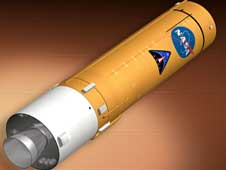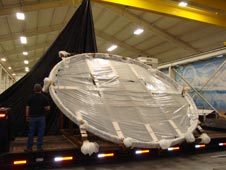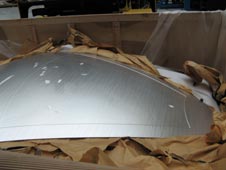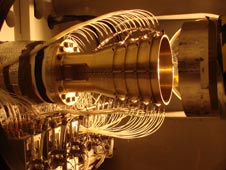August 2008 Ares Update
08.25.08
This issue of Update includes the latest, vital information about:
- Ares Projects Reviews Pass Major Milestones
- Friction Stir Welding a Key Technology for Ares Rockets
- Thrust Oscillation Status
- J-2X Nozzle Testing -- Engineers Fine-tune Design

Ares I upper stage. Image Credit: NASA/Boeing View large image
Ares Projects Reviews Pass Major MilestonesUpper Stage Completes Preliminary Design Review
On Aug. 5, the Ares I upper stage team successfully completed its preliminary design review, and gained overall approval for NASA's technical design approach.
This just-completed preliminary design review, conducted at NASA's Marshall Space Flight Center in Huntsville, Ala., looked at current designs for the upper stage to ensure that the planned technical approach will meet NASA’s requirements for the vehicle.
This review was part of a series of milestones that will occur before the actual flight hardware is built. Each major review provides more detailed requirements for the vehicle design to ensure the overall system can meet all NASA requirements for safe and reliable flight. The review process also identifies technical and management challenges and addresses ways to reduce potential risks as the project goes forward.
Ares Integrated Vehicle Preliminary Design Review Kick-off
Ares Projects recently kicked off the process that will set the final design for the Ares I rocket with the Ares I preliminary design review July 28. Detailed design presentations were given which focused on requirements and engineering, internal and external interfaces, integrated performance, avionics and software, crew safety and reliability, operability and supportability, test and verification, and overall project risk. The preliminary design review will conclude on Sept. 10 with an assessment of the Project's readiness to proceed to critical design review for the Ares I launch vehicle.

Ares I-X. Image Credit: NASA
View large image
The Ares I-X team successfully completed its critical design review on July 24. Engineering analysis and data were presented to an independent panel, which agreed that the Ares I-X vehicle design is complete. Hardware manufacturing continues for the flight vehicle, with individual hardware elements shipping to the Kennedy Space Center beginning in September.
Ares I-X -- the first test flight of an Ares I design rocket –will provide the Ares I team with data and analysis on flight controllability, hardware, facilities and ground operations prior to the Ares I critical design review. The Ares I-X launch is planned for 2009.

Y-ring delivery for Ares I production. Image Credit: NASA View large image
Friction Stir Welding a Key Technology for Ares RocketsThe world's largest known welding machine of its type -- capable of building major components of both NASA's Ares I and Ares V rockets -- has been installed at the Marshall Center this summer.
The robotic weld tool uses forging pressure and frictional heating to produce high-strength component bonds virtually free of defects. Friction stir welding transforms the Al-Li alloy from a solid state into a "plastic-like" state, and then methodically stirs the materials together under pressure to form a welded joint.
Initial tests using gore panels from the space shuttle began in August with a demonstration weld using external tank hardware. Testing on Ares I components being fabricated on this unique machinery is set to begin later this year.
Y-Ring Delivery for Ares I Production
A fixture designed for use with the self-reacting friction stir welder in the production of the Ares I rocket fuel tanks has been delivered to the Marshall Center by the Futuramic Tool & Engineering Company of Warren, Mich.
This fixture, or clamp, will hold the y-rings in place while they are being welded to fuel tank domes. All domes have y-rings attached for welding to the barrel panels. The barrel panels comprise the major portion of the liquid hydrogen and liquid oxygen tanks. The barrels are capped on either end by the forward and aft domes.
The highly reliable and low cost friction stir welding process will be used to assemble different components of the upper stage of the Ares I to a greater degree than is used on the External Tank Program for the space shuttle.

Aluminum-lithium external tank dome gores. Image Credit: NASA
View large image
In the first of a series of tests to demonstrate future Ares I rocket upper stage friction stir welding tasks, engineers began welding space shuttle external fuel tank dome gores Aug. 11. The initial test consisted of friction stir welding two aluminum-lithium (Al-Li) external tank dome gores together using the robotic weld tool.
The robotic weld tool will be used to develop the manufacturing techniques required to fabricate the tanks of the Ares I upper stage. This series of tests will lay the ground work for future work on the Ares I upper stage. The tool is critical for manufacturing the main propulsion test article, which will demonstrate the functionality of the upper stage. Back to Top

Thrust Oscillation chart. Image Credit: NASA View large image
Thrust Oscillation StatusThe thrust oscillation focus team has developed several solutions and options to eliminate thrust oscillation on the Ares I rocket. In early August, the team provided options to address thrust oscillation and made recommendations to the Constellation Program about how to move forward to implement changes to mitigate this issue. In September they will brief the Exploration System Mission Directorate leadership at NASA Headquarters in Washington on the decision path. NASA managers will evaluate these recommendations and then move forward with the selected design and mitigation plan. Back to Top

J2-X engine. Image Credit: NASA
View large image
"Nozzle side loads" are a major design consideration for rocket engine exhaust nozzles. The J-2X is no exception. Side loads, or pressures exerted on the sides of the engine nozzle, are most severe during engine start as the rocket exhaust plume fills the nozzle, as well as at shutdown when the plume empties from the nozzle, pressing unevenly around the nozzle walls. Engineers must make the nozzle strong enough to withstand those uneven forces. Yet they must not risk over-designing it, which could add needless weight that detracts from the launch vehicle's overall payload capability. Testing at the Marshall Center's Nozzle Test Facility enables Pratt & Whitney Rocketdyne design engineers to characterize these side loads and apply this test data to computer analyses used to design the nozzle to withstand the side loads.
Subscale nozzle test articles were developed to simulate the J-2X nozzle -- both with and without the turbine exhaust gas injection. In the J-2X engine exhaust, gas from the turbines that pump propellants to the combustion chamber will be injected around the nozzle extension to provide a cooling barrier against the hotter combustion chamber exhaust, as well as provide additional engine thrust. This film coolant flow has a noticeable impact on the nozzle side loads. The recent tests simulated rocket exhaust flow, using warm air instead of hot rocket exhaust -- a process termed "cold flow" testing.
Since testing began in March, more than 1,000 J-2X nozzle start simulations have been performed. Test results to date have benefited the design by showing that the side loads are actually significantly less than the original analytical predictions, thus enabling designers to reduce the weight of the nozzle and nozzle extension designs. Engineers continue to evaluate the data obtained to further refine the predicted loads for J-2X nozzle and nozzle extension. Follow-on testing is planned through September, with the objective to obtain data on the film coolant's thermal effectiveness.
Marshall Space Flight Center, Huntsville, Ala.
June.E.Malone@nasa.gov